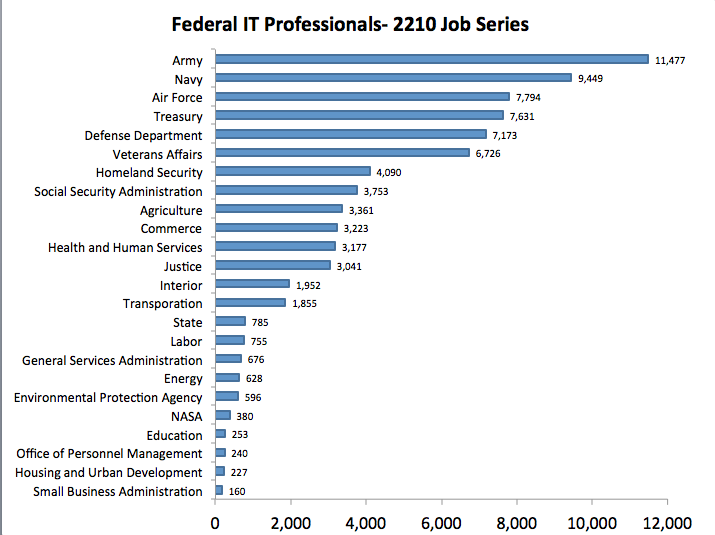This story is part of a bi-weekly GovLoop series called “The Intersection”. The goal is to make technology relevant and easy to understand for all government employees. Consider this blog the bridge that connects you (the tech user) with the tech innovators and policy makers.

If you’ve asked any federal hiring manager for advice on landing an IT job, I’m sure at least one person has directed you here: USAJobs.gov.
I know, I know — it kind of feels like a let down. The last thing any eager applicant wants to hear is the URL address for a site that has been called clunky, a cyber abyss and a black hole for dumping resumes. One Forbes article plainly states what some in government know as fact — “all too often, that perfect looking position on USAJobs was created as a formality for someone who is already inside the system. Someone who has already practically accepted the position internally.”
Before you go losing all hope, know that the Office of Personnel Management is working to make the site user-friendly. And I’m not suggesting you totally boycott USAJobs.gov altogether. Rather, I’m here to give you practical tips for landing that IT job and jumpstarting your career. (Here are a couple of tips for those searching on USAJobs.)
For answers, I turned to Richard McKinney, CIO at the Department of Transportation and head of the CIO Council’s IT Workforce Committee, McKinney’s Deputy, Kristen Baldwin, and Jason Walsh, Coordinator for the IT Workforce Committee. I also got a few pointers from Ron Sanders, a Vice President and Fellow at Booz Allen Hamilton. Sanders’ lengthy career in federal human resources roles includes the Office of Personnel Management’s first Associate Director for Human Resource Policy.
Rather than cram everything you need to know in one story, I’ll diverge from The Intersection’s bi-weekly schedule and publish part II of this story on Aug. 4.
Figuring Out Where You Fit In
Let’s start with the basics. In researching for this story I wanted to know who made up the federal IT workforce. How many federal IT professionals does the government employ and where are they located? According to the most recent OPM data, there are 82,178 federal employees classified under the information technology management series 2210.
But that number doesn’t include several smaller agencies and intelligence agencies, including the CIA, National Security Agency, Defense Intelligence Agency, Board of Governors of the Federal Reserve and the White House Office. There are other nuances that prevent the public from having a complete picture of the IT workforce, including the fact that some legislative branch entities are accounted for but not the judicial branch. There are also feds who identify as IT professionals but are classified under different occupational series. For example, although OPM replaced the 334 job series for computer specialist with 2210, some people still identify themselves as belonging to the old series, according to a 2011 IT workforce survey.
“We’ve done a good job of inventorying our data centers, and computers, and iPads and phones, but we haven’t done a good job of inventorying our people and what they actually do on a daily basis,” Walsh said.
It gets more confusing if you’re trying to match your skills to position descriptions on USAJobs and determine where you fit within the vast IT workforce.
Part of the issue is a lack of updated position descriptions. Think of all the mini assignments and tasks you’ve picked up at your current job that were not included in your original job description. “To go back every day and write your PD is cumbersome,” Walsh said.
Even within the 2210 series there are a dozen parenthetical titles, such as customer support and systems administration, that further describe what you do as an IT professional. Some people choose a primary or secondary parenthetical title while others have titles not formalized by OPM or they don’t use one at all. Wouldn’t it be so much easier if this were all condensed?
“It would behoove both sides of the fence, both the government and the potential applicant, to simplify and clarify this,” said McKinney, who is involved in making that a reality.
The goal: “We’re working [toward] a simplified way to describe job roles across the federal government,” Walsh explained.
Tailor Your Job Search
Not all IT jobs are created equally. There are many reasons why that’s the case, but one in particular is that different hiring authorities are tied to different jobs. For example, agencies have been granted direct-hire authority to fill information security specialties, Sanders said. This basically means that agencies can hire full-time, qualified candidates on the spot. In May, former OPM Director Katherine Archuleta authorized the use of excepted-service appointments to bring more digital services experts into government for limited terms.
It’s no secret that landing a federal job — from application time to start date — can take months, but focusing your job search on positions with these hiring flexibilities can reduce the wait, Sanders noted. If you are qualified for those positions, Sanders suggests applying for them first.
“There are some agencies that are leveraging those flexibilities, and they are going to be able to get to a candidate quicker and make an offer,” he said. But as noted earlier, these positions are only for a limited time. They can, however, be your ticket into government and enable you to overcome the hardest barrier: getting in. (In part II of this series I’ll touch on the challenges IT managers face in using these authorities).
This may be stating the obvious, but using key words from the job description in your resume and application can help. At the very least you want your resume to make it past the automated hiring software and into the hands of a human for review.
Get Connected, Stay Connected
But nothing beats knowing the hiring manager personally and fostering those relationships. The database for all current jobs is out there, “but it really is [about] knowing people in the industry,” Walsh said.
McKinney agrees. It’s not about people providing favors, but rather applicants knowing how to market themselves and connect with hiring managers.
“You’d be surprised at how many people come up to me, hand me a business card and say, ‘I’d love to come work for you,’” McKinney said. “And I come back, and I’ll say, ‘OK, here’s my card, send me your resume.’”
Sometimes the exchange leads to McKinney encouraging a potential applicant to apply for a position, or referring the person to an opening that may be a good fit at another agency.
For those of you who live in D.C., there is not shortage of free IT training events and networking opportunities hosted by GovLoop and other organizations. If there’s a particular agency or bureau you’re interested in working for, find out the CIO’s speaking schedule, or set up Google Alerts so you can stay current on key initiatives and coverage of that agency and CIO. This will be particularly helpful for people who live outside of the D.C. area and don’t have regular access to CIOs and hiring mangers at headquarters. Attending virtual training IT events, asking questions and following up with speakers is another way to connect.
I can’t stress how important it is to know and understand where agencies’ IT departments are currently, where they are heading and what their needs are. Defense Department CIO Terry Halvorsen has called out contractors for trying to do business with DoD but not knowing basic information, such as the fact that the Navy and the Marine Corps are two separate service branches. Likewise, potential hires should also do their homework and get a sense of the agency’s goals and where they fit into the vision and mission of the organization.
Part II of this series offers more tips for getting your foot in the door, insight on what hiring managers look for in potential candidates and challenges agencies face when using hiring authorities.






[…] So You Want to Land a Federal IT Job? (Part I) is available here. […]